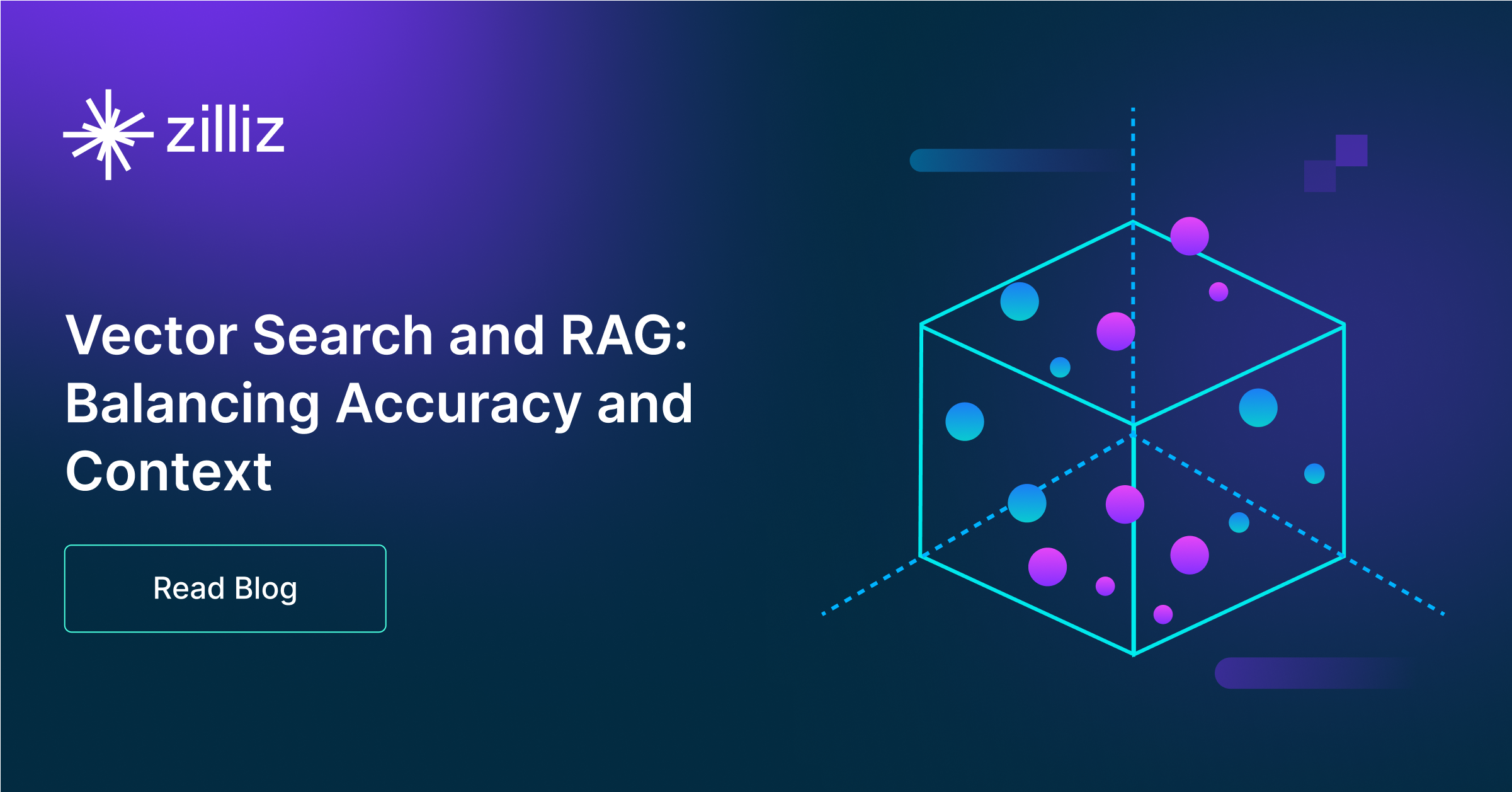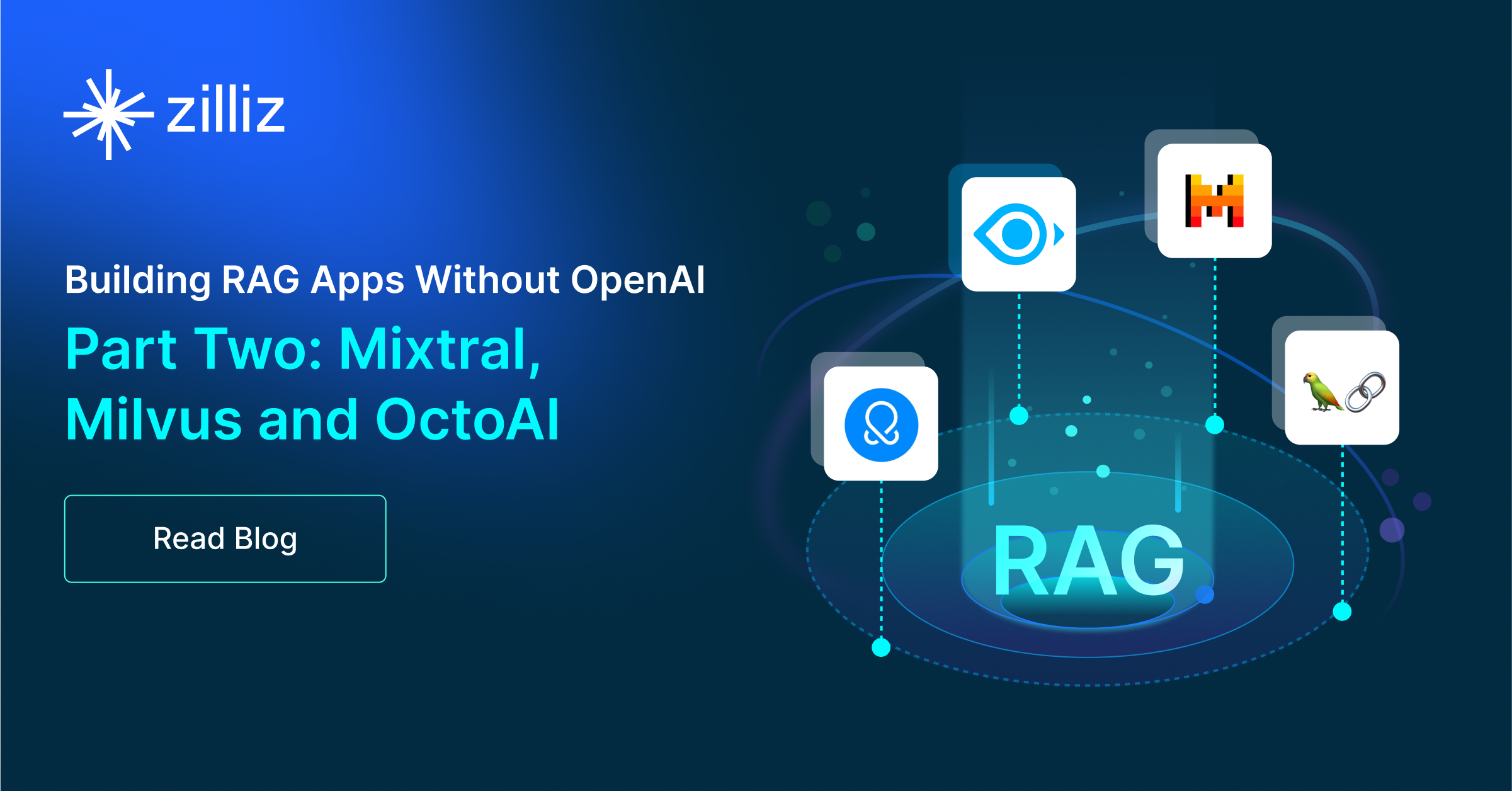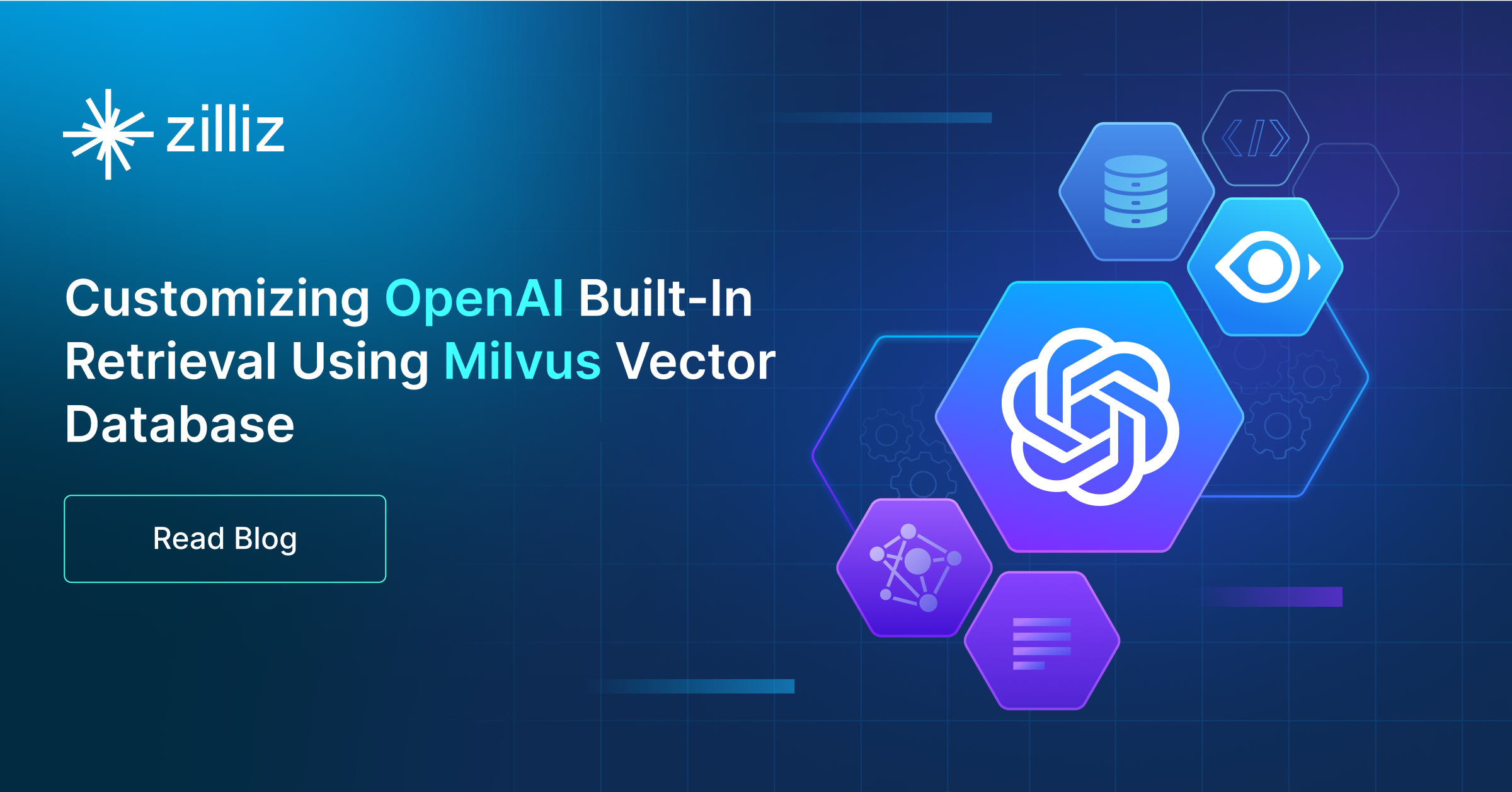Build RAG Chatbot with Llamaindex, Faiss, Mistral Pixtral, and Ollama mxbai-embed-large
Introduction to RAG
Retrieval-Augmented Generation (RAG) is a game-changer for GenAI applications, especially in conversational AI. It combines the power of pre-trained large language models (LLMs) like OpenAI’s GPT with external knowledge sources stored in vector databases such as Milvus and Zilliz Cloud, allowing for more accurate, contextually relevant, and up-to-date response generation. A RAG pipeline usually consists of four basic components: a vector database, an embedding model, an LLM, and a framework.
Key Components We'll Use for This RAG Chatbot
This tutorial shows you how to build a simple RAG chatbot in Python using the following components:
- Llamaindex: a data framework that connects large language models (LLMs) with various data sources, enabling efficient retrieval-augmented generation (RAG). It helps structure, index, and query private or external data, optimizing LLM applications for search, chatbots, and analytics.
- Faiss: also known as Facebook AI Similarity Search, is an open-source vector search library that allows developers to quickly search for semantically similar multimedia data within a massive dataset of unstructured data. (If you want a much more scalable solution or hate to manage your own infrastructure, we recommend using Zilliz Cloud, which is a fully managed vector database service built on the open-source Milvus and offers a free tier supporting up to 1 million vectors.)
- Mixtral: A high-performance, sparse mixture-of-experts (MoE) language model designed for efficient text generation and comprehension. Excelling in multilingual support and domain adaptability, it balances speed and accuracy, making it ideal for enterprise-scale applications, real-time chatbots, and resource-constrained environments requiring cost-effective AI solutions.
- Ollama mxbai-embed-large: A high-performance embedding model optimized for converting text into dense vector representations, excelling in semantic similarity tasks. It features multilingual support, efficient processing of long documents, and low-latency inference, making it ideal for semantic search, document clustering, content recommendation, and retrieval-augmented generation (RAG) pipelines.
By the end of this tutorial, you’ll have a functional chatbot capable of answering questions based on a custom knowledge base.
Note: Since we may use proprietary models in our tutorials, make sure you have the required API key beforehand.
Step 1: Install and Set Up Llamaindex
pip install llama-index
Step 2: Install and Set Up Mistral Pixtral
%pip install llama-index-llms-mistralai
from llama_index.llms.mistralai import MistralAI
llm = MistralAI(model="pixtral-12b-2409")
Step 3: Install and Set Up Ollama mxbai-embed-large
%pip install llama-index-embeddings-ollama
from llama_index.embeddings.ollama import OllamaEmbedding
embed_model = OllamaEmbedding(
model_name="mxbai-embed-large",
)
Step 4: Install and Set Up Faiss
%pip install llama-index-vector-stores-faiss
from llama_index.core import (
SimpleDirectoryReader,
load_index_from_storage,
VectorStoreIndex,
StorageContext,
)
from llama_index.vector_stores.faiss import FaissVectorStore
vector_store = FaissVectorStore(faiss_index=faiss_index)
Step 5: Build a RAG Chatbot
Now that you’ve set up all components, let’s start to build a simple chatbot. We’ll use the Milvus introduction doc as a private knowledge base. You can replace it with your own dataset to customize your RAG chatbot.
import requests
from llama_index.core import SimpleDirectoryReader
# load documents
url = 'https://raw.githubusercontent.com/milvus-io/milvus-docs/refs/heads/v2.5.x/site/en/about/overview.md'
example_file = 'example_file.md' # You can replace it with your own file paths.
response = requests.get(url)
with open(example_file, 'wb') as f:
f.write(response.content)
documents = SimpleDirectoryReader(
input_files=[example_file]
).load_data()
print("Document ID:", documents[0].doc_id)
storage_context = StorageContext.from_defaults(vector_store=vector_store)
index = VectorStoreIndex.from_documents(
documents, storage_context=storage_context, embed_model=embed_model
)
query_engine = index.as_query_engine(llm=llm)
res = query_engine.query("What is Milvus?") # You can replace it with your own question.
print(res)
Example output
Milvus is a high-performance, highly scalable vector database designed to operate efficiently across various environments, from personal laptops to large-scale distributed systems. It is available as both open-source software and a cloud service. Milvus excels in managing unstructured data by converting it into numerical vectors through embeddings, which facilitates fast and scalable searches and analytics. The database supports a wide range of data types and offers robust data modeling capabilities, allowing users to organize their data effectively. Additionally, Milvus provides multiple deployment options, including a lightweight version for quick prototyping and a distributed version for handling massive data scales.
Optimization Tips
As you build your RAG system, optimization is key to ensuring peak performance and efficiency. While setting up the components is an essential first step, fine-tuning each one will help you create a solution that works even better and scales seamlessly. In this section, we’ll share some practical tips for optimizing all these components, giving you the edge to build smarter, faster, and more responsive RAG applications.
LlamaIndex optimization tips
To optimize LlamaIndex for a Retrieval-Augmented Generation (RAG) setup, structure your data efficiently using hierarchical indices like tree-based or keyword-table indices for faster retrieval. Use embeddings that align with your use case to improve search relevance. Fine-tune chunk sizes to balance context length and retrieval precision. Enable caching for frequently accessed queries to enhance performance. Optimize metadata filtering to reduce unnecessary search space and improve speed. If using vector databases, ensure indexing strategies align with your query patterns. Implement async processing to handle large-scale document ingestion efficiently. Regularly monitor query performance and adjust indexing parameters as needed for optimal results.
Faiss Optimization Tips
To enhance the performance of the Faiss library in a Retrieval-Augmented Generation (RAG) system, begin by selecting the appropriate index type based on your data volume and query speed requirements; for example, using an IVF (Inverted File) index can significantly speed up queries on large datasets by reducing the search space. Optimize your indexing process by using the nlist parameter to partition data into smaller clusters and set an appropriate number of probes (nprobe) during retrieval to balance between speed and accuracy. Ensure the vectors are properly normalized and consider using 16-bit or 8-bit quantization during indexing to reduce memory footprints for large datasets while maintaining reasonable retrieval accuracy. Additionally, consider leveraging GPU acceleration if available, as Faiss highly benefits from parallel processing, leading to faster nearest neighbor searches. Continuous fine-tuning and benchmarking with varying parameters and configurations can guide you in finding the most efficient setup specific to your data characteristics and retrieval requirements.
Mistral Pixtral optimization tips
To optimize Mistral Pixtral in a RAG setup, fine-tune its prompt engineering by using clear, structured instructions to guide context integration. Limit retrieved documents to the most relevant chunks (e.g., 3-5) to reduce noise and improve response quality. Adjust temperature (0.2-0.5) for balanced creativity and precision. Use dynamic batching for parallel processing to accelerate inference. Implement quantization (e.g., 4-bit) to reduce memory usage without significant performance loss. Regularly evaluate retrieval alignment with domain-specific benchmarks to refine embedding and reranking strategies.
Ollama mxbai-embed-large optimization tips
Optimize Ollama mxbai-embed-large in RAG by preprocessing input text: clean, normalize, and chunk documents into 256-512 token segments for balanced context. Use batch inference to parallelize embedding generation, reducing latency. Fine-tune the model on domain-specific data if labeled pairs are available. Cache frequent or static embeddings to avoid recomputation. Ensure hardware acceleration (e.g., CUDA) is enabled. Test cosine similarity thresholds for retrieval accuracy and adjust based on downstream tasks. Regularly update the vector database with fresh data to maintain relevance.
By implementing these tips across your components, you'll be able to enhance the performance and functionality of your RAG system, ensuring it’s optimized for both speed and accuracy. Keep testing, iterating, and refining your setup to stay ahead in the ever-evolving world of AI development.
RAG Cost Calculator: A Free Tool to Calculate Your Cost in Seconds
Estimating the cost of a Retrieval-Augmented Generation (RAG) pipeline involves analyzing expenses across vector storage, compute resources, and API usage. Key cost drivers include vector database queries, embedding generation, and LLM inference.
RAG Cost Calculator is a free tool that quickly estimates the cost of building a RAG pipeline, including chunking, embedding, vector storage/search, and LLM generation. It also helps you identify cost-saving opportunities and achieve up to 10x cost reduction on vector databases with the serverless option.
 Calculate your RAG cost
Calculate your RAG cost
What Have You Learned?
Congratulations on completing this exciting tutorial! You've just taken a significant step towards mastering the integration of key technologies to build a powerful Retrieval-Augmented Generation (RAG) system. Throughout this tutorial, you’ve learned how to weave together a structured framework using LlamaIndex, a vector database like Faiss, a sophisticated Large Language Model (LLM) with Mistral Pixtral, and a stellar embedding model like Ollama mxbai-embed-large. Each of these components plays a crucial role in transforming raw data into actionable insights, allowing your RAG system to retrieve relevant information effectively and generate high-quality content tailored to user needs. Remember the optimization tips, especially regarding embedding strategies, which can significantly enhance the performance of your RAG applications. And don’t forget to make use of the free RAG cost calculator we provided—it's a handy tool to help you budget your resources wisely and plan your project efficiently.
Now that you’ve got a solid foundation, think of the endless possibilities you can explore! Whether you’re enhancing customer interactions, developing personalized content, or diving into unique applications, the skills you've just acquired open doors to innovation and creativity. So go ahead—start building your own RAG applications, iterate on your designs, and push the boundaries of what’s possible. Let your curiosity lead the way, and embrace the challenge. After all, the world is waiting for your insights and ingenuity. Happy building!
Further Resources
🌟 In addition to this RAG tutorial, unleash your full potential with these incredible resources to level up your RAG skills.
- How to Build a Multimodal RAG | Documentation
- How to Enhance the Performance of Your RAG Pipeline
- Graph RAG with Milvus | Documentation
- How to Evaluate RAG Applications - Zilliz Learn
- Generative AI Resource Hub | Zilliz
We'd Love to Hear What You Think!
We’d love to hear your thoughts! 🌟 Leave your questions or comments below or join our vibrant Milvus Discord community to share your experiences, ask questions, or connect with thousands of AI enthusiasts. Your journey matters to us!
If you like this tutorial, show your support by giving our Milvus GitHub repo a star ⭐—it means the world to us and inspires us to keep creating! 💖
- Introduction to RAG
- Key Components We'll Use for This RAG Chatbot
- Step 1: Install and Set Up Llamaindex
- Step 2: Install and Set Up Mistral Pixtral
- Step 3: Install and Set Up Ollama mxbai-embed-large
- Step 4: Install and Set Up Faiss
- Step 5: Build a RAG Chatbot
- Optimization Tips
- RAG Cost Calculator: A Free Tool to Calculate Your Cost in Seconds
- What Have You Learned?
- Further Resources
- We'd Love to Hear What You Think!
Content
Vector Database at Scale
Zilliz Cloud is a fully-managed vector database built for scale, perfect for your RAG apps.
Try Zilliz Cloud for Free


